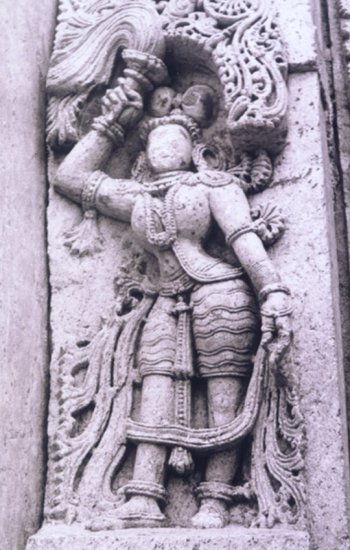Devadasi - Servant of God
by Jyotsna Kamat
First Online: December 01, 2005
Page Last Updated: December 07, 2024
Dr. Kamat takes a look at the historical context of the institution of Devadasis. In the course of history the so called "temple women" were both honored and exploited in the name of God. The author points out that at one time, they were regarded as honorable professionals, and are responsible for development of many of India's performing fine-arts. - Ed.
Dedicating dancing girls to temples in the service of God was not peculiar to India. Many ancient civilizations, like those of Babylonia, Cyprus, Phoenicia, Greece, Mesopotamia, Egypt, and Syria employed young girls to propitiate their deities in their respective temples. In the temple of Corinth, we are told, hundreds of prostitutes lived in the precincts of the temple and the main income of the shrine was from the income of these courtesans. Contemporary norms found no stigma if rich clientele associated themselves with such women, who in their spare time entertained the rich and wealthy.
India was no exception. Although ancient texts like Vedas, Upanishads do not mention Devadasis (servants of God), institutionalized worship of idols in temples during early centuries of Christian era led to the practice of dedicating women to temples as laid down in the puranas. Thus some puranas (Agni Purana and Bhavishya Purana) specifically state that the best way for a man to obtain Suryaloka (heaven of sun god) was to dedicate a group of dancing girls to the temple of sun. For many kings and rich merchants it was the most affordable way to earn merit! (Punya)
Over a period of time all the "pampered family deities" of kings and nobles started getting pretty and talented servants for different rituals performed for the deity (befitting a great king or deity) like bathing, dressing, offering flowers, music and dance. Their main job was to dance and sing as also playing musical instruments, while the priests of the temple offered sixteen kinds of services. But smaller temples employed them for cleaning the temple premises, fetch water, make garlands of flowers, etc. By the time Hiuen Tsang came to India (7th century) Devadasi system was firmly established. He had noticed a large number of them in the sun temple of Multan (now in Pakistan). In Somnath temple (which was destroyed and looted by Muhmmad Gazni) there were five hundred dancing girls and in the great Tanjore temple built by Rajaraja Chola (10th century) there were four hundred.
© K. L. Kamat

Temple Woman Depicted in a Hoysala Sculpture
Just like the kings employing women for various chores in the palace, women were employed in temples for different seva or services like fanning, holding chamar during procession, preparing ointments for the idol. They also participated in state-plays enacted before the deity during festivals. Some of the Devadasis were highly accomplished and earned lot of wealth. Many courtesans were of charitable nature. The biggest tank in the state of Karnataka for instance, was constructed by Shantavve, a Devadasi, in the 11th century (water tank that spread ten miles and fed 7000 acres agricultural land in Chennagiri taluka of Shimoga district.) It is called Sulekere (Prostitute's Lake) by the locals and subsequently renamed as Shantigagar. Even today (year 2005) it is as serviceable.
There were seven types of Devadasis as per Hindu tradition.
- Datta -- self-dedicated, or given to deity
- Vikrita -- Purchased or self-sold to God,
- Bhritya -- servant for supporting family
- Bhakta devotee -- Devadasi
- Abducted and deserted at the temple
- Alankara--donated by kings or nobles to their family deity
- Rudra Ganika or Gopika--appointed by the temple for specific services
The last two find mention in inscriptions as well and hence it is seen that their job was primarily service of the deity. Since they were wedded to the deity, they could not marry a mortal. However they had to cater to demands of the employer or the priest and as is a common curse of India, a separate caste came into existence. The sons of temple women continued as temple staff or musicians and daughters became dancers and musicians. For centuries Devadasis continued to be custodians of fine arts. They studied classics (Sanskrit and regional languages.) Set to music lyrics and played and taught various musical instruments and kept the tradition of Bharatanatya or Indian classical dance alive. No stigma was attached for their profession. Their presence at marriage and other festive occasion was required. some got the tali (auspicious thread of a bride) tied by a Devadasi during wedding.
K.L. Kamat/Kamat's Potpourri
Picture of a Courtesan Performing
Detail from a picture postcard. The caption on the back says " Courtesans have proved they are as Indian as you"
But the arrival of British followed by missionaries dealt a cultural death blow to the institution of Devadasis. The Europeans could not distinguish between Devadasis, prostitutes, and street nauch girls. It was considered vulgar and lowly to attend concerts of Devadasis or attend dance performances. English educated Indians were suddenly aware of their status and the laws were passed to ban the practice. By then the impoverished dancing women had to take recourse to prostitution for mere survival. The abolition of Devadasi system in 1920s did help to stop exploitation of poorer women in the name of religion. But superstitions regarding dedicating female child still continue in parts of India, such as the devotion to Yellamma.
![]()
